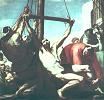More Counter-Reformation Art |
More Counter-Reformation Art |
The Council of Trent gave important instruction on the use of images. Through images the faithful would be confirmed and instructed in the articles of faith. Through images of the saints, the people could see the miracles of God and salutary examples of the faithful. Additional requirements for this imagery were clarity, realistic interpretation, and an emotional stimulus to piety. Artists in Catholic countries were affected by this advice, often creating paintings and sculpture to further Catholic orthodoxy. Many works of art in this period emphasize the power of intercessions by the Virgin and the saints, as well as the orthodoxy of miracles and other mysteries of the faith. Another important strategy of the Counter-Reformation was to revive the reputation of long-neglected saints or near-forgotten miracles.
|
Josť de Ribera The Martyrdom of St. Bartholomew c. 1639 |
|

|
Like Caravaggio, the Spanish painter Ribera depicts the saint realistically. A Spanish peasant could relate to this unidealized, swarthy, ordinary person. In addition, the painting is emotional and shocking, for St. Bartholomew is being skinned alive. The painting reminds Catholic viewers of those who were willing to die for their faith and perhaps of those missionaries who were still suffering as they attempted to convert peoples in faraway lands. |
|
de La Tour The Penitence of St. Jerome c. 1628-30
|
|

|
St. Jerome was one of the early "Church Fathers." In the 4th century he had translated most of the Vulgate Bible (in Latin). In 1546 the Council of Trent named the Vulgate the only authoritative biblical text for Roman Catholics, and it remained so until 1943. Recall that Bernini's Cathedra Petri depicted "Church Fathers" as well. The Church Fathers were important in the Counter-Reformation because they had formed the fundamental doctrines and practices of the Latin church in the early centuries of Christianity. Their representation in art was a way to reassert the precedence and time-honored traditions of the Roman Catholic church.
In fact, St. Jerome's importance rose during Counter-Reformation. The Council of Trent ranked Jerome as the most important church father. Sometimes his role as a scholar, the translator of the Latin Bible, was emphasized. However, this painting emphasizes another side -- his asceticism. Jerome had retired to the desert to a cave to deny himself the pleasures of the world and the flesh, but he suffered visions of temptations. He mortified himself by beating his flesh with a stone (in the foreground) and whipping himself. Penance for sins was one of major sacraments of Roman Catholic church. It demanded the intercession of a priest, and thus it was received new emphasis during Counter-Reformation.
|
All images marked MAS were photographed on location by Mary Ann Sullivan. All other images were scanned from other sources or downloaded from the World Wide Web; they are posted on this password-protected site for educational purposes, at Bluffton College only, under the "fair use" clause of U.S. copyright law.